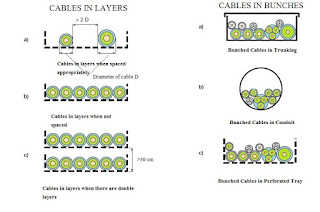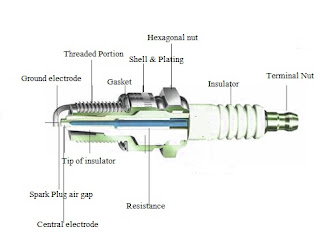There are following
procedure to be adopted for correct dimensioning of a plant
(i)
Load Analysis:-
First step in dimensioning of a plant is to check for connected load and
their location
Now check for location of power distribution panels
Now we can calculate cable requirement i.e. length of cables and path of
cable laying
Now we will do calculations of total power consumption while taking
account utilization factors and demand factors
(ii)
Transformer and generator size calculations:-
Transformer and generator size are usually selected 15-30% more in
comparison to total connected load considering future prospectus.
(iii)
Conductor size selection-
Now we calculate cable
size according to load requirement of various connected loads. Cable selected
may be copper or aluminum. Cables selection must also consider voltage drop at
load current under specific reference conditions.
(iv)
Selection of Protective
circuit breaker:-
Short circuit calculations can be done and accordingly
switchgear busbar and switchgear should be selected. It is always considered to
select circuit breaker with breaking capacity higher than short circuit
current. Rating of circuit breaker should be higher than rated current of load
connected to circuit breaker. Characteristics of circuit breaker should be
according to connected to load.
(v)
Protection of
conductors:-
For protection against overload circuit breaker rating should be
higher than the load current but should be lower than Rated current carrying
capacity of conductor.
In case of short circuit protection circuit breaker setting
should be lower than short circuit current withstand by conductor.
(vi)
Protection of Load:-
For protection of load such as motors which constitute 70% of total load
of any industrial and commercial establishment overload relays and other
protections must be provided after breaker so that tripping of relays leads to
protection of load. For protection of human beings from electrical shocks it is
always recommended to install RCCB or ELCB.
Selection of the cable
For installation and
calculation of current carrying capacity of cables in Industrial, commercial
and houses cable selection should be as per International standard IEC
60364-5-52 i.e. “Electrical installations of buildings Part 5-52 for “Selection
and Erection of Electrical Equipment- Wiring systems”.
There are following ways and parameters are used to select the
cable type:
a)
Conductivity of
Material:-
The foremost parameters to be considered while selection of
cables is conductivity of material. Copper is costlier then aluminum but
selection depends upon cost of material, size of material , weight of material,
resistivity of material and resistivity to corrosive environment. Generally
copper is having higher current carrying capacity i.e. 30% higher than aluminum
conductors for same cross-sectional area, this is due to fact that aluminum is
having higher resistivity than copper i.e. 60% higher than copper conductor.
b)
Insulating Material used for conductors:-
There are so many insulating materials used for copper or
aluminum conductors. Insulating material may or may not be used for conductors.
Materials used for conductors may be PVC, XLPE. Insulating material will
affects maximum temperature that a cable able to carry under normal and short
circuit conditions.
c) Type of conductor:-
There
are following types of conductors:-
a)
Bare conductor
b)
Single core cable without sheath
c)
Single core cable with sheath
d)
Multicore cable with sheath and armored
e)
Flexible multicore cable
Cable can be selected according to mechanical resistance, degree
of insulation and difficulty of installation required by the method of
installation.
Conductors reduction factor while laying the cables in different
arrangement of laying the cables:-
It has been observed
that with presence of other cables laid around the cable , cable current
carrying capacity is influenced significantly. This happens because heat
dissipation of single cable get affected due to presence of other cables
nearby.
Below we will discuss
effect of other cables on current carrying capacity of single cable. For same
there is factor K2 comes into picture according to installation of cables laid close together in layers or
bunches.
The value of correction
factor K2= 1 when:
Distance between two
single core cables of different circuits is more than twice that of external
diameter of the cable with larger cross section.
Adjacent cables are
loaded less than 30% of current carrying capacity.
The correction factors
for cables which are either bunched or laid in layers is usually calculated by
assuming that all cables laid in bunches
are similar cables and also load on cables is same. The calculation of the
reduction factors for bunched cables with different crosssections depends on
the number of cables and on their cross sections. These factors have not been
tabled, but must be calculated for each bunch or layer.
The reduction factor
for a group containing different cross sections of insulated conductors or
cables in conduits, or cable ducting is:
where:
K2= 1/(n)1/2
• K2 is the group reduction
factor;
• n is the number of
circuits of the bunch.
The reduction factor
obtained by this equation reduces the danger of overloading of cables with a
smaller cross section, but may lead to under utilization of cables with a
larger cross section. Such under utilization
can be avoided if large and small cables are not mixed in the same group.
The following tables
show the reduction factor (k2).
Reduction Factor for grouped
cables:-
Item
|
Arrangement (Cables Touching)
|
1
|
2
|
3
|
4
|
5
|
6
|
7
|
8
|
9
|
12
|
16
|
20
|
To be used with current- carrying capacities
Reference
|
1
|
Bunched in air/ on
a Surface/ enclosed
|
1.00
|
0.80
|
0.70
|
0.65
|
0.60
|
0.57
|
0.54
|
0.52
|
0.50
|
0.45
|
0.41
|
0.38
|
Method A to F
|
2
|
Single layer on
wall, floor or flat tray
|
1.00
|
0.85
|
0.79
|
0.75
|
0.73
|
0.72
|
0.72
|
0.71
|
0.70
|
No further reduction factor for more than nine circuits or multicore cables
|
Method C
|
||
3
|
Single layer fixed
directly under a wooden ceiling
|
0.95
|
0.81
|
0.72
|
0.68
|
0.66
|
0.64
|
0.63
|
0.62
|
0.61
|
||||
4
|
Single layer on perforated
tray or vertical tray
|
1.00
|
0.88
|
0.82
|
0.77
|
0.75
|
0.73
|
0.73
|
0.72
|
0.72
|
Method E & F
|
|||
5
|
Single layer on
ladder support
|
1.00
|
0.87
|
0.82
|
0.80
|
0.80
|
0.79
|
0.79
|
0.78
|
0.78
|
||||

